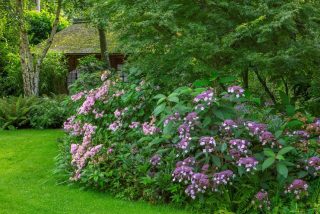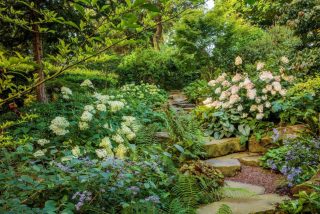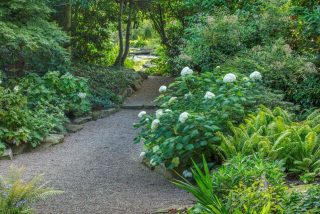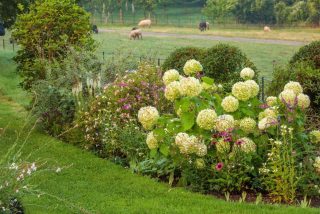Last but by no means least!
As summer slowly fades into autumn, there is one last group of plants in the garden that are worthy of our attention. Their flowers hold on to the very last moments of summer and as the sun gets lower in the sky, the autumn light seems to amplify their beauty. They are, of course, the hydrangeas.
The Rockery and Stroll Garden at Morton Hall with their dappled shade and moist growing conditions are very suitable for growing these lovely shrubs.

Although the flowers are the main attraction at this time of year, the foliage of hydrangeas is also worthy of consideration from the soft, velvet-like leaves of Hydrangea aspera in the Stroll Garden to the unusual bright white undersides to the leaves of Hydrangea paniculata ‘Limelight’ at the top of the Rockery. Also, in the Rockery we grow several cultivars of the Oak-leaved hydrangea (H. quercifolia) with its distinctive, large, divided leaves resembling an Oak leaf. Hydrangeas can be slow to shoot in the spring and their foliage can be susceptible to overnight spring frosts. Therefore, a sheltered position away from cold winds is ideal.

But it is the showy flowers that we have been waiting for and although they keep us waiting through the spring and summer, by late summer the waiting is over. It is the paniculata hydrangeas in the Rockery which have perhaps the most impressive floral display. Their large white panicles of small white flowers tinged with pink or light green provide a light backdrop to the autumn flowering asters and they hold onto their colour long into the autumn.

However perhaps the largest of all the hydrangea flowers are those of Hydrangea arborescens ‘Annabelle’. Growing in the West Garden it produces a profusion of large white spherical flower heads which provide contrast to the upright Lythrum virgatum ‘Dropmore Purple’ and Echinacea ‘Fatal Attraction’.
The pruning of Hydrangeas is also important for the best floral
display and different species are pruned individually. All hydrangeas
are pruned in early spring after the worst of the winter weather with
the larger flowered H. arborescens coppiced right to ground level. H.
paniculata are spur pruned back with the previous season's growth taken
back to 1 or 2 buds from the woody framework. H. macrophylla and H.
quercifolia are pruned for shape with 2 or 3 of the oldest stems being
removed to the base to encourage the production of new stems for
flowering the following year.

As the herbaceous perennials get cut back in the autumn, there is still colour and interest left in the dried hydrangea flower heads in the winter, and they are a reminder of the warmer and sunnier days of summer.
